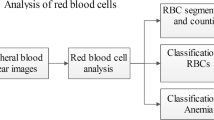Abstract
Bacterial colony enumeration is an essential tool for many widely used biomedical assays. However, bacterial colony enumerating is a low throughput, time consuming and labor intensive process since there may exist hundreds or thousands of colonies on a Petri dish, and the counting process is usually manually performed by well-trained technicians. In this paper, we introduce a fully automatic yet cost-effective bacterial colony counter which can not only count but also classify colonies. Our proposed method can recognize chromatic and achromatic images and thus can deal with both color and clear medium. In addition, the proposed method is software-centered and can accept general digital camera images as its input. The counting process includes detecting dish/plate regions, identifying colonies, separating aggregated colonies, and reporting colony counts. In order to differentiate colonies of different species, the proposed counter adopts one-class Support Vector Machine (SVM) with Radial Basis Function (RBF) as the classifier. Our proposed counter demonstrates a promising performance in terms of both precision and recall, and is robust and efficient in terms of labor-and time-savings.















Similar content being viewed by others
References
Breed, R., & Dotterrer, W. D. (1916). The number of colonies allowable on satisfactory agar plates. Journal of Bacteriology, 1, 321–331.
Chang, C. W., Hwang, Y. H., Grinshpun, S. A., Macher, J. M., & Willeke, K. (1994). Evaluation of counting error due to colony masking in bioaerosol sampling. Applied and Environmental Microbiology, 60, 3732–3738.
COLIFAST, (2008) Retrieved March 3, 2008, from http:// www.colifast.no.
Dahle, J., Kakar, M., Steen, H. B., & Kaalhus, O. (2004). Automated counting of mammalian cell colonies by means of a flat bed scanner and image processing. Journal of the International Society for Analytical Cytology, 60, 182–188.
Etzion, O., Fisher, A., & Wasserkrug, S. (2005). E-CLV: A Modeling Approach for Customer Lifetime Evaluation in e-Commerce Domains, with an Application and Case Study for Online Auction. Information Systems Frontiers, 7(4/5), 421–434.
Hough, P. V. C. (1962). Method and means for recognizing complex patterns. United States Patent, 3, 069–654.
Holt, J. G. (1994). Bergery’s manual of determinative bacteriology (9th ed.). Baltimore: Williams and Wilkins.
Huang, J., Kuman, S. R., Mitra, M., Zhu, W. J., & Zabih, R. (1997). Image indexing using color correlogram. In The Proc. of the IEEE International Conference on Computer Vision and Pattern Recognition (pp. 762–768).
Karel, Z. (1994). Contrast limited adaptive histogram equalization. Graphics Gems IV: Academic Press Professional, Inc, 447–485.
Liu, W., Wang, T., & Zhang, H. (2000). A Hierarchical characterization scheme for image retrieval. In Proc. of International Conference on Image Processing. (pp. 42–45). Vancouver, BC, Canada.
Liu, X., Wang, S., Sendi, L., & Caulfield, M. J. (2004). High-throughput imaging of bacterial colonies grown on filter plates with application to serum bactericidal assays. Journal of Immunological Methods, 292, 187–193.
Luc, V., & Pierre, S. (1991). Watersheds in Digital Spaces: An efficient algorithm based on immersion simulations. IEEE Transactions on Pattern Analysis and Machine Intelligence, 13, 583–598.
MacQueen, J. B. (1967). Some methods for classification and analysis of ultivariate observations, proceedings of 5-th berkeley symposium on mathematical statistics and probability. Berkeley, University of California Press, 1, 281–297.
Niyazi, M., Niyazi, I., & Belka, C. (2007). Counting colonies of clonogenic assays by using densitometric software. Radiation Oncology, 2(4).
Otsu, N. (1979). A threshold selection method from gray-level histograms. IEEE Transactions on Systems, Man, and Cybernetics, 9(1), 62–66.
Putman, M., Burton, R., & Nahm, M. H. (2005). Simplified method to automatically count bacterial colony forming unit. Journal of Immunological Methods, 302, 99–102.
Schölkopf, B., Platt, J. C., Taylor, J. H., Smola, A. J., & Williamson, R. C. (1999). Estimating the support of a high-dimensional distribution. (Technical Report NO. MSR-TR-99–87). Microsoft Research Corporation.
Seber, G. A. F. (1984). Multivariate observations. New York: Wiley.
Stricker, M., & Dimai, A. (1996). Color indexing with weak spatial constraints. In Proc. of SPIE Storage and Retrieval of Still Image and Video Databases IV. (pp. 29–40). San Jose, CA, USA.
Tomasiewicz, D. M., & Peeler, J. T. (1980). The most suitable number of colonies on plates for counting. Journal of Food Protection, 43(4), 282–286.
Zhang, C., & Chen, W. B. (2007). An effective and robust method for automatic bacterial colony enumeration. In Proc. of the IEEE International Workshop on Semantic Computing and Multimedia Systems, in Conjunction with the 2007 International Conference on Semantic Computing (pp. 581–588), Irvine, CA, USA.
Acknowledgement
This research of Dr. Zhang is supported in part by NSF DBI-0649894 and the UAB ADVANCE program through the sponsorship of the National Science Foundation.
Author information
Authors and Affiliations
Corresponding author
Rights and permissions
About this article
Cite this article
Chen, WB., Zhang, C. An automated bacterial colony counting and classification system. Inf Syst Front 11, 349–368 (2009). https://doi.org/10.1007/s10796-009-9149-0
Published:
Issue Date:
DOI: https://doi.org/10.1007/s10796-009-9149-0




